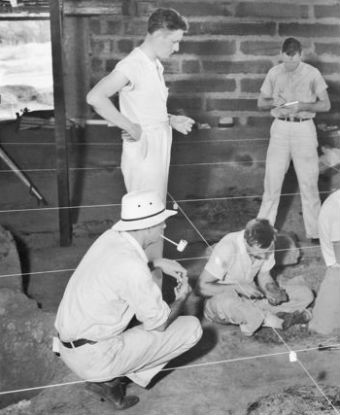Last updated: September 5, 2023
Person
Arthur Kelly

National Park Service
Arthur Kelly was born on October 27, 1900 in Hubbard, Texas. He graduated from the University of Texas in 1921, where he studied physical anthropology. He received his Masters in 1925 and his PhD in 1929 from Harvard University. He became a Fellow at the National Research Council and began studying physical traits of Cherokee individuals, but resigned to take an assistant professorship at the University of Illinois. There, he taught classes and directed archeological fieldwork at sites including Starved Rock State Park and Powell Mound at the famed Cahokia Mounds.
In 1933, Kelly moved to Macon, Georgia to run the archeological excavations at the Ocmulgee Old Fields (today Ocmulgee Mounds National Historical Park). These excavations were one of five Smithsonian-sponsored projects that provided a suffering workforce with income during the Great Depression. It would become the largest archeological dig ever conducted within the United States.
As Director, Kelly supervised a workforce of 700-800 individuals employed by the Works Progress Administration, specifically the Civil Works Administration, the Federal Emergency Relief Administration, and the Civilian Conservation Corps. Engineers produced scaled maps and soil profiles while illustrators drew in-situ (in place) finds. Some individuals worked as weekend tour guides, when up to 3000 people visited the site. Crews were stationed at different sites all around Ocmulgee, including one at Swift Creek composed entirely of African-American women. Daily, Kelly walked between these sites and dictated his interpretations to secretary Charlie Tidwell. By the time the excavations were finished, over 2.5 million artifacts were recovered.
The Ocmulgee Project ran until 1937. In that year, Kelly was made the Chief Archeologist for the National Park Service and moved to the Washington, D.C. headquarters. While in a more administrative role, he continued to participate in excavations. In 1938, he helped run a field school in Chaco Canyon alongside Florence Hawley Ellis, Donovan Senter, and Robert Lister. The next summer, he was at Dunlap Farm with Gordon Willey, where together they produced a dendrochronological (tree-ring) dating sequence for Georgia dating back to 1700.
In 1941, the National Park Service eliminated the Chief Archeologist position. Kelly was reassigned to the Custom’s House in Salem, Massachusetts as its Superintendent. Two years afterwards, he requested to be transferred back to Ocmulgee as a “way to get back to some digging” (Willey, 45). He remained in the position of Superintendent and worked alongside archeologist Charles Fairbanks.
In 1946, after ten years, Kelly left the National Park Service and became a professor at the University of Georgia. In the following years, he became an archeological consultant to the state of Georgia and a founding member of the Georgia Historical Commission and the Society for Preservation of Early Georgia History. He worked at sites all across the state including Estatoe Mound, Bell Field, Etowah, Sixtoe, and Mandeville. In 1949, he ran a summer field school near Kolomoki State Park, the oldest and largest Woodland site in the southeastern United States. Kelly officially retired in 1967 but continued his excavations at Bell Field. He died on November 4, 1979.
Sources:
1. Stories: The Largest Archeological Dig in America History. Ocmulgee National Monument, National Park Service.
2. Willey, Gordon Randolph. Portraits in American Archaeology: Remembrances of Some Distinguished Americanists. University of New Mexico Press, Albuquerque, 1988.
The following sources are available from the LAMAR Institute:
3. Dear Isabel: Archeological Correspondence. A.R. Kelly and Isabel Patterson, 1934-1953. Compiled and edited by R. Jerald Ledbetter. LAMAR Institute Publication 33, University of Georgia, 1995.
4. In His Own Words: An Interview with Dr. Arthur Kelly (1900-1979). Edited by Mark Williams. LAMAR Institute Publication 44, University of Georgia, 1997.
5. Kelly, Arthur. WPA Archeological Excavations at the Macon North Plateau. 2010.
Ramblings with Kelly. Edited by Mark Williams. LAMAR Institute Publication 7, University of Georgia, 1990.
